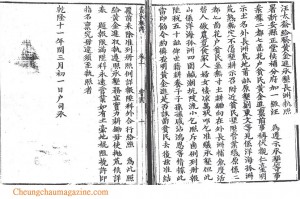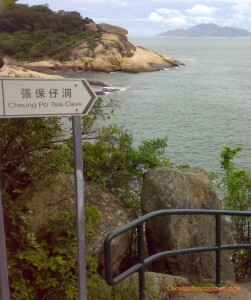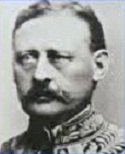1810 Jan 01
Cheung Po Tsai, Pirate, 1806-1810
Cheung Po Tsai, Pirate, 1806-1810
According to Pun Yu County record in late Ching Dynasty, Cheung Po , was the pirate in Southern China coast.
Cheung Po went out fishing with his father when he was around 15 years old, and was captured by Red Flag pirate leader of South China, Cheng Yat, who was descendant of Cheng Shing Kung, the famous sea explorer of Ming dynasty.
Cheng Yat later died in typhoon. His wife promoted Cheung Po as assistant to control the Red Flag pirates.
For his young age, other pirates started calling him Po Tsai. (literally in English, kid Po)
Cheung Po Tsai active leadership of Red Flag pirates only lasted between 1806 and 1810.
As a result of fear of revenge by another leader, Kwok Por Dai, of Black Flag pirates, and on the advice by wife of Cheng Yat, he surrendered to Ching Government.
He was given a position of military officer in Ching army, got officially married with wife of Cheng Yat. She later started casino business in Macau.
Cheung Po Tsai used Tung Chung of Lantau Island as repair and maintenance base, and once broke through the blockage set up in Chek Lap Kwok by joint force of Ching and Portuguese navies.
Based on report of 2 East India Company sailors kidnapped by Cheung Po Tsai, he had over 500 boats and around 25,000 pirates under his command at his peak.
Cheung Po Tsai Cave on Cheung Chau
Please response to this post, your comment is important to us
Cheung Chau in 1898
1898 Oct 01
Cheung Chau in 1898
When Stewart Lockhart, Special Commissioner to Hong Kong , wrote a report to Colonial Office in Oct 1898 after taking over New Territories which includes outlying islands, this is how he described Cheung Chau in his report :
“The Island of Cheung Chau is a busy place, at which many of the steamers, launches, and junks plying between Hong Kong and Macao call.
There is a station of the Chinese Imperial Maritime Customs on the Island, as there is also on the Island of Ma Wan, commonly known as the Kap Shui Mun Station.
The deep anchorage of Cheung Chau affords good shelter, especially during easterly gale.
He also remarked the population of Cheung Chau at 5,000 in 1898, based on the estimate from the officer of the Chinese Imperial Maritime Customs stationed at Cheung Chau.”
But a British, L C Arlington, the expatriate employed by Ching Dynasty as Imperial Maritime Customs Officer stationed at Cheung Chau between 1894-98, recalled a different aspect of life in his book. “The exceptionally strong smell from raw fish and shrimp paste under the sun was almost everywhere on the island. It made him very difficult to set foot on Cheung Chau again after 6 long years of service on the island.”
Chinese Imperial Maritime Customs at Cheung Chau
Please response to this post, your comment is important to us
Land Court , 1900
1900 Jan 01
Land Court , 1900
Since the issue of Chinese Notice in 1899 by the Governor, Henry Blake, informing all land owners in New Territories and Outlying Islands to claim land ownerships, Colonial Government received great amount of land claim disputes, amounting to 69,253 cases, as reported by Stewart Lockhart in his report to Government in 1902.
(參閱 : Ching Dynasty New Territories and outlying islands Land Tenure, before 1898)
Colonial Government enacted the No 18th Ordinance in Hong Kong, the Land Court Ordinance to establish Land Court to handle all theses claim disputes.
Mr. H E Pollock was appointed President, Mr. Gompertz was appointed member, and Mr. Kemp appointed as Registrar.
“ First sitting of Land Court did not take place till 20th February 1901 on Ma Wan Island, then frequent intervals to Cheung Chau and Ping Chau.
Mr. Pollock and me also went to Liyumoon to sit in Chinese Temple for hearing, and Cha Kwo Lang to sit in vacant shop for hearing.” remarked by H H J Gompertz as President of Land Court in report to Colonial Government dated 15th March 1902.
(參閱 : British Colonial Government Policy on land administration in New Territories, 1899)
In 1905, Land Court member J R Wood submitted his report to Colonial Government and listed out the chief problems for settlement :
“Many large tracts of land are now claimed by persons who have never paid Crown Rent on them, who never reported their occupation, such as it was to the authorities, and whose claims have never in any way recognised by the Chinese Government.
Very many persons have been paying under the name of tax annual sums to families who professed to be giving an account of these sum to District Treasury but who as a matter of fact very often did nothing of the kind and who in many cases had no real title to more than a very small fraction of the territory over which they collected this rent. “
J R Wood went on to comment “ The claims to large tracts have for the most part on investigation proved untenable, while the Tax-collecting families or Taxlords, as we have called them., have , where they can show documents in support of their income of any part of it, been provided for in ways appropriate to each case on recommendations of the Court.”

Wong Wai Tsak Tong Clan’s book land title record |

Wong Wai Tsak Tong clan’s book land title record |

Wong Wai Tsak Tong clan’s book land title record |
Please response to this post, your comment is important to us
British Colonial Government Policy on land administration in New Territories, 1899
1900 Jan 17
British Colonial Government Policy on land administration in New Territories, 1899
Bruce Shepherd, then Deputy Land Officer, stated clearly in his report to Government dated 17th January, 1900, of British Colonial Government Policy in land administration in New Territories.
The policy would be based on the Land Registration Ordinance of 1843, requiring all land owners to register their land ownerships from Ching Dynasty, they would then be issued title deeds for a period of 99 years.
Henry Blake, the Governor, issued a Chinese notice on 12th July 1899 informing all land owners of New Territories and Outlying Islands to file their claims of land ownerships.
Stewart Lockhart emphasised all owners ought to bring along their Ching Dynasty title deeds in person, submit the filled-in claim form to visiting officer to the village.
A list of land owner names would be posted in the village for 7 days. If there was no dispute, a certificate of title would be issued to individual owner after payment of Crown Rent.
If there were disputes, the case would be passed on to Squatters Board for examination and the outcome would be decided by Governor.
All land in New Territories would be surveyed for its size and exact location, land not claimed would be British Colonial Government land.
“ Do not say that I have not warned you here, do not show disobedience.” Henry Blake.
 |
 |
|
English Land Claim Form |
Chinese Land Claim Form |
Please response to this post, your comment is important to us
The number of posts displayed per page : 5






